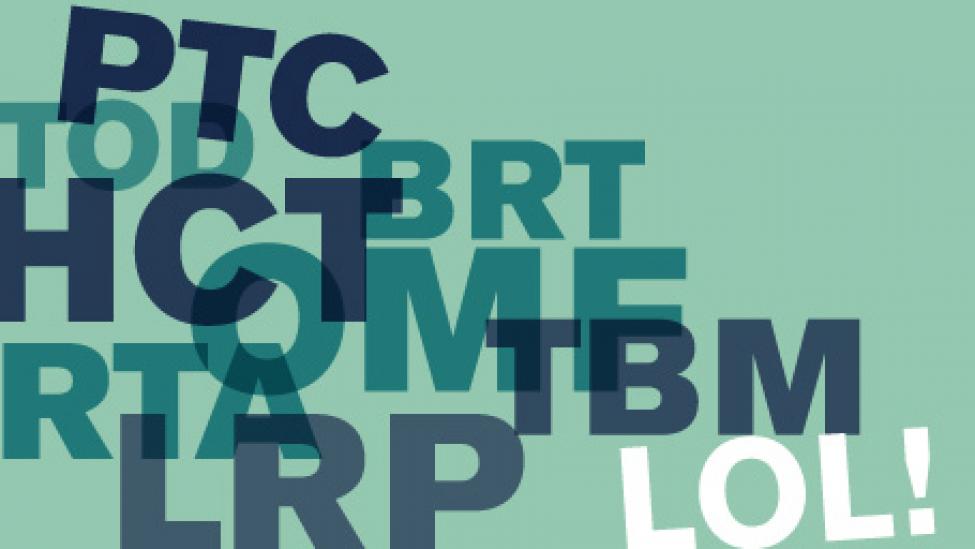
Learn the lingo: 10 terms for transit fans
With various transit projects underway in the Puget Sound, it can be difficult to decode all the planning, construction and operational talk. We've pulled together some common lingo used in Sound Transit documents and transit news. Study the terms, use them in a conversation and you're on your way to becoming a transit geek!
Bus rapid transit (BRT) - an enhanced bus system that operates on bus lanes or other transitways in order to combine the flexibility of buses with the efficiency of rail. By doing so, BRT operates at faster speeds, provides greater service reliability and increased customer convenience.
Sound Transit is conducting studies to evaluate potential future high- capacity transit (HCT) options in main corridors across the region, which includes evaluating BRT as a transit solution.
Gantry crane - a crane that lifts objects by a hoist which is fitted in a hoist trolley and can move horizontally on a rail or pair of rails fitted under a beam. Gantry cranes are particularly suited to lifting very heavy objects.
A gantry crane is used on the South 200th Link extension project to lift the pre-cast segments into place that make up the overhead trackway for light rail to travel.
Headway - time interval between vehicles moving in the same direction on a particular route. The headway on Link light rail is as little as seven minutes during peak times.
High-capacity transit (HCT) - a service operating principally on exclusive rights-of-way and providing a substantially higher level of passenger capacity, speed and service frequency than public transit operating on highways and city streets in mixed traffic.
As part of the 2008 voter-approved Sound Transit 2 plan, conceptual-level HCT corridor studies are underway to inform the Sound Transit Board's consideration of potential updates to the long-range plan.
Long-range plan (LRP) - a blueprint for future development of the regional transit system. It identifies proposed transit service in major corridors and shows how a regional transit system might best accommodate the region's growth.
Sound Transit is in the process of updating its LRP. The public comment period on the Draft SEIS ended July 28 and the Board will update the LRP in December.
Transit oriented development (TOD) - planning and building a mix of housing, business and other amenities close to transit stations. When clustered around a station, this development increases ridership by making it easier for people to use transit, supporting local businesses and making neighborhoods better places to live, work and spend time.
In 2012, the Board adopted a TOD policy that provides goals and guidance that staff may use to evaluate, facilitate and implement development as it builds the regional transit system. The future Capitol Hill Station has five building sites for TOD.
Tunnel boring machine (TBM) - sophisticated tunnel construction equipment. The TBM, which is about the size of a football field and weighs several hundred tons, can dig through all types of soil from rock to sand. It also builds the concrete tunnel liner and seals the pieces together.
The University Link extension project required three TBMs to dig tunnels between the downtown Seattle transit tunnel and Capitol Hill, and Capitol Hill and the UW.
Operations maintenance facility / operations maintenance satellite facility (OMF/OMSF) - Sound Transit's existing OMF is a four-story, 162,000-square-foot building that contains component repair shops, electronics repair shop, a signals and communications lab and a communications maintenance shop. The future OMSF site will be used to store, maintain and dispatch vehicles for daily service as well as preventative maintenance inspections, light maintenance, emergency maintenance, interior vehicle cleaning, and exterior car washing.
The current OMF in SODO is not big enough to house the additional vehicles needed for more than 30 miles of Link expansion. Therefore, Sound Transit will build an OMSF to meet the maintenance and storage needs of the expanded light rail fleet identified in ST2. A site in Bellevue's Bel-Red corridor has been identified as the preferred location.
Positive train control (PTC) - an integrated information system for controlling train movements with safety and security. PTC adds equipment on locomotives and on the ground along corridors so trains can be automatically slowed or stopped if they are going too fast or in the wrong location.
Sound Transit is installing a PTC system in Lakewood and Tacoma as part of a federally mandated PTC communication network.
Regional transit district tax (RTA tax) - Sound Transit is funded by a combination of local taxes, federal grants, fares, interest earnings and miscellaneous revenues. Local taxes make up just over half of Sound Transit's total funding. In 1996, 2008 and 2016, voters within the RTA district approved tax increases to build and operate the regional mass transit system. These taxes are assessed only within the Sound Transit district:
| Tax | Total Imposed/Levied* |
|---|---|
| Sales & Use | 1.4% ($0.14 on a $10 taxable purchase) |
| MVET | 1.1% ($110 annually for each $10,000 of vehicle valuation) |
| Property Tax | $0.25 annually per $1,000 of assessed valuation ($100 annually on a $400,000 house) |
| Rental car sales tax | 0.8 percent ($0.80 on a $100 car rental) |